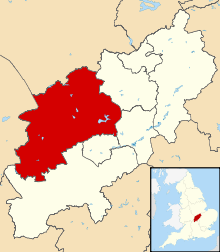Moulton, Northamptonshire
| Moulton | |
.jpg) St Peter & St Paul's Church |
|
 Moulton |
|
| Population | 3,454 (2011 Census) |
|---|---|
| OS grid reference | SP784663 |
| Civil parish | Moulton |
| District | Daventry district |
| Shire county | Northamptonshire |
| Region | East Midlands |
| Country | England |
| Sovereign state | United Kingdom |
| Post town | NORTHAMPTON |
| Postcode district | NN3 |
| Dialling code | 01604 |
| Police | Northamptonshire |
| Fire | Northamptonshire |
| Ambulance | East Midlands |
| EU Parliament | East Midlands |
| UK Parliament | Daventry |
|
|
Coordinates: 52°17′21″N 0°50′57″W / 52.28922°N 0.84907°W
Moulton is a large village in the Daventry district of the county of Northamptonshire in England. The population of the civil parish at the 2011 Census was 3,454.[1]
Education
There are many pre-school facilities in the village including playgroups and nurseries. Primary education in the village is provided by Moulton Primary School, although it is not uncommon for children to attend other primary schools in the local area, for example Overstone, Pitsford or Parklands primary schools.
Moulton Secondary School and Science College is a comprehensive school providing education for 11- to 18-year-olds, not only to those from Moulton but also to students from the surrounding villages.
Moulton is home to Moulton College, an agricultural and trade orientated college.
Church
The Church of England parish church is dedicated to St Peter and St Paul.
Notable residents
John Sanderson (1578/9-c.1653) was living at Moulton in 1606/7. He purchased a substantial quantity of land in the parish in 1629 and apparently remained there for much if not all of the rest of his life.
The village was the 18th-century home of William Carey. The church where he ministered, and the cottage in which he lived, are located at the west end of West Street. The village also has links with John Jeyes (of Jeyes Fluid fame) as Holly Lodge is found on the road from Moulton to Boughton (a building associated with the family). Holly Lodge has the 'Implement gate' (c 1955), which is iconic of the rural beginnings of Moulton.
Amenities
The stone-built Gothic Revival style Methodist Chapel of 1835 with arched windows is next to the old school of 1878, now used by the Moulton Theatre.
Moulton hosts an annual village festival (held in May) and is home to the Moulton Morris Dancers. The Moulton Sports Complex is also home to the Village Hall and is the current site of the Northampton Saints Hockey Club,
The centre of Moulton houses the parish church and some shops and a post office. The local Co-op store was run by the Moulton Co-operative Society, an independent society and one of Britain's smallest until its merger with Midlands Co-operative Society in 2009.
Moulton is home to a number of pubs including the iconic Cardigan Arms, The Telegraph, The Artichoke, a working men's club. Moulton also contains, on its fringe, the Northampton Fire and Rescue Service Headquarters.
Geology
The geology of Moulton is based on sedimentary rocks known as Oolite. Cornbrash, Inferior and Great Oolite rocks have dictated that the soils of Moulton are predominantly sands and clays, but small quantities of ironstone may be found.[2] This ironstone was used extensively for construction of buildings in and outside of Moulton. Moulton's elevation lies at 400-600ft above sea level and the nature of the soil means that it is relatively free of flooding and drains well without becoming too dry. The alluvial nature of the soil means that it is fertile and can be used to grow a wide range of plants.
Geography
Moulton has a population of over 3,000. It is situated about 4 miles (6 km) north of central Northampton. Moulton has been affected by the expansion of Northampton yet retains a village identity. It is thought that the village has its origins in Saxon times, although the main features of the present church are Norman or later. Moulton is a village of narrow winding lanes, lined by stone-built cottages and houses, nowadays with traffic calming and one-way systems. In the area of Moulton Leys in the south, the Kettering Road takes residents from Moulton to Northampton town centre.
The boundaries of Moulton extend from Pitsford reservoir in the north to Moulton Lane in the south. In the east, the A43 (Kettering Road) is the border, with a small quantity of land that adjoins the east side of the A43 near Ashley Lane. The western fringe corresponds with all land east of Spectacle Lane.
The topography of Moulton is generally flat, but the gradient of land runs from a higher southern elevation in towards lower parts, in the village centre, and then elevates again in a northern direction. At the northern boundary the lower elevations of the reservoir are separated from the village by a strip of high ground.
In the village centre, a tributary of the Nene river flows from the east of the village in a westerly direction where it joins the Nene near Chapel Brampton. Medieval fish ponds in the village were fed from this tributary.
Crowfields Meadow is part of Moulton village and boasts a range of wildlife and plants. Boughton Lane Pocket Park on the Southern end of Moulton is another source of animal and plant biodiversity.
References
- ↑ "Civil Parish population 2011". Neighbourhood Statistics. Office for National Statistics. Retrieved 7 July 2016.
- ↑ Martin, R.A. & Osborn, G. 1976. An Outline of the Geology of Northamptonshire, Northamptonshire Natural History Society and Field Club.
External links
| Wikimedia Commons has media related to Moulton, Northamptonshire. |
- Parish Council
- Moulton Focus
- Moulton Secondary School
- Moulton Primary School
- Moulton Magpies
- Moulton Parish Church
- Carey Baptist Church, Moulton
